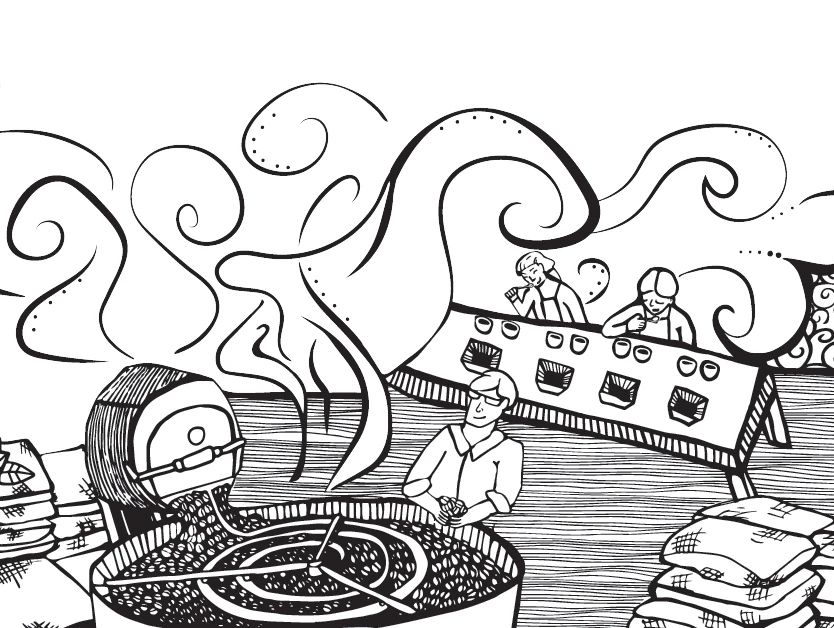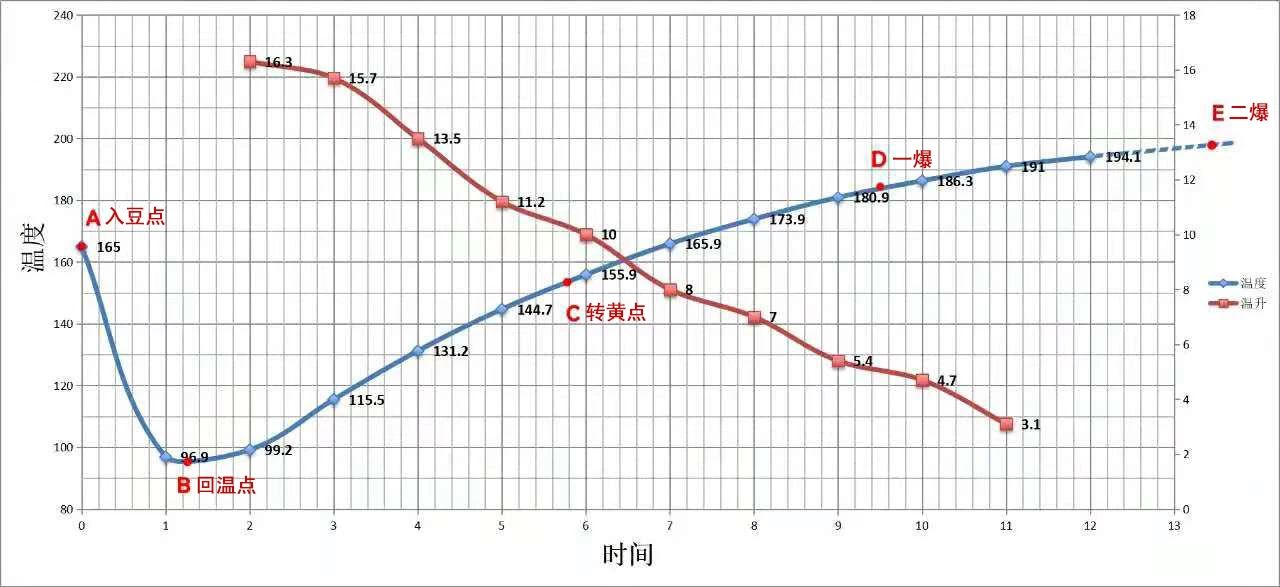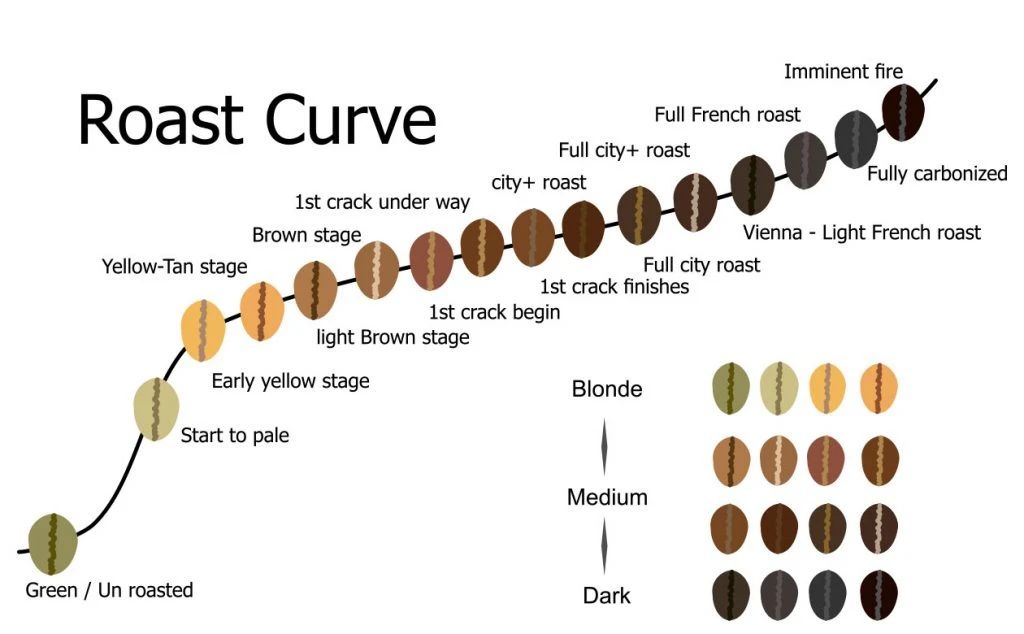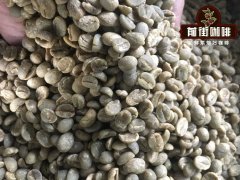What is the principle of roasting coffee beans? What professional terms do you need to know to learn coffee roasting
Guide reading
Then, after learning about the ingredients, this lesson will learn the principle of coffee roasting and some coffee roasting terms.
The so-called coffee roasting is very similar to food cooking, using heat to make food tastier, more smellable, and more beautiful. The purpose of learning roasting is to find the most suitable roasting method for coffee beans.

Know about the roaster
There are all kinds of baking utensils, such as hand net, iron pot and popcorn machine. But today, it is only for professional roasters, which can be divided into direct type, semi-direct type (semi-hot air type) and hot air type.
Direct fire type: the use of flame direct heat transfer to coffee beans, the advantage is the performance of coffee flavor and aroma ability is good, the disadvantage is difficult to control, easy to scorch coffee beans, clip raw beans phenomenon. It is a great test of the bakery.
Semi-direct fire type: use the flame to heat the porous drum, the flame can not be in direct contact with the coffee bean, but through the metal drum heat and heat conduction air hole to heat the coffee bean. The advantage is stability. Most roasters use semi-direct fire to produce cooked coffee beans.
Hot air type: use the blower to inhale the air, then let the air pass through a heating coil to raise its temperature, and use hot air as the heating source to bake coffee beans. The advantage is that it is easy to control the temperature and not easy to scorch. The disadvantage is that the performance of flavor and aroma is insufficient compared with the former two.

Nouns you need to know in baking
There are often some key nodes in baking. Let's understand the name and meaning of these key nodes.
Entry point: this is the node where coffee beans enter the boiler, and it is also the beginning of the baking curve calculation. generally, the furnace temperature at the bean entry point is relatively high, and the furnace temperature is different according to the amount of raw beans or the raw beans in different producing areas. Generally, the temperature of entering beans will be controlled between 160200 ℃.
Temperature recovery point: coffee beans will absorb heat quickly after entering the boiler, and the furnace temperature will continue to drop, stabilize when falling to a certain temperature, and then rise, this inflection point is called the temperature recovery point.
Turn yellowing point: in about 6 minutes, the raw beans whose water content is mostly turquoise begin to turn yellow, and the folds on the bean surface appear slowly. This point is called the turning yellow point.
The first burst: commonly known as "an explosion", before an explosion, coffee beans are in an endothermic state. When the beans accumulate enough energy and expand, they burst and release heat. It is generally judged that the beginning of an explosion is to hear sporadic 4-5 sounds.
The second burst: if we do not choose to come out, but continue to develop, there will be a quiet period of 1-2 minutes after the end of the first explosion, and then there will be a second explosion. It is also 4-5 sound to judge the beginning of the second explosion, the second burst sound is not strong, but appears to be a low sound.

And between these nodes, there is also a time address between two points.
Dehydration period: refers to the period from the entry of beans to the yellowing point, although the dehydration process runs through the whole baking period, but this period is the period when the amount of evaporation of raw coffee beans is the most. The length of the dehydration period depends on the moisture content and hardness of raw coffee beans.
Relay period: refers to the yellow dot to the beginning of the explosion, this period, the surface of coffee beans become light brown, begin to expand and release steam, emitting the aroma of toast.
Development period: refers to the period from the beginning of the explosion to the baking, after the explosion, the coffee beans are physically "ripe", and the amount of time of development also determines the flavor trend of coffee beans. It is very simple to sum up that underdevelopment will lead to entanglement and lack of flavor. Short development time will tend to acid tonality, long development time will tend to bitter tonality, excessive extension of development time may also smooth the flavor of coffee.

Because the degree of development of coffee beans is different, the degree of roasting is also different, according to the color value of coffee beans is divided into eight baking degrees.
Agtron color value # 95: light baking (Light Roast)
Release time: the density of an explosion is coming to an end.
Agtron color value # 85: cinnamon baking (Cinnamon Roast)
Time of release: around the end of the first explosion
Agtron color value # 75: medium baking (Medium Roast)
Release time: after the end of the first explosion
Agtron color value # 65: deep baking (High Roast)
Time of release: the quiet period between the first explosion and the second explosion
Agtron color value # 55: urban baking (City Roast)
Time of release: the second explosion begins.
Agtron color value # 45: city-wide baking (Full City Roast)
Time of release: before the second explosion is dense
Agtron color value # 35: French baking (French Roast)
Time of release: when the second explosion is dense
Agtron color value # 25: Italian baking (Itatian Roast)
Baking time: the oil begins to seep out of the bean table

What can we actually control during baking?
Take the semi-direct fire roaster as an example, we can only control the incoming bean (time, temperature), firepower control, throttle control and out-of-furnace time.
Firepower control is similar to the gentle fire and martial fire when we cook. Increasing the firepower will speed up the heating, reducing the firepower will make the heating slow, and the heating required in different periods of coffee roasting will be different, which requires us to regulate the firepower.

The function of the throttle is to remove water vapor and silver from the boiler, as well as auxiliary firepower to regulate and control the temperature. At the beginning of an explosion, there will be more smoke, then it is necessary to open a big throttle to draw away the smoke, which will avoid the feeling of smoke in the coffee. However, if the heat is not enough to enlarge the throttle, it may lead to loss of temperature and loss of coffee flavor.

Learning coffee roasting has a long way to go, and only when the basic theory is solid, we will not be caught by surprise. And this process is always boring!
Important Notice :
前街咖啡 FrontStreet Coffee has moved to new addredd:
FrontStreet Coffee Address: 315,Donghua East Road,GuangZhou
Tel:020 38364473
- Prev

Introduction to coffee bean roasting how to distinguish the characteristics of coffee beans with defective beans
The roasting of coffee beans is like the cooking of ingredients. The roaster's knowledge of raw coffee beans is as important as the chef's understanding of ingredients. Chefs have to experience loading before going to the stove, in order to do a good job in basic skills. The same is true of roasting, before tampering with the roaster, a comprehensive understanding of raw coffee beans lays a decisive foundation for future roasting.
- Next
Evaluation of Red Standard Rosa Coffee Bean Flavor and Taste of Jadeite Manor in the New season in 2021
At the end of April, the only 300 grams of red sign rose left in Qianjie was sold out in the form of drinks only, and then we ushered in a day without red marks for more than a month. Today, Panamanian Emerald Manor Red label Rose Summer Coffee beans, it is back! The new red sign of the new year was yesterday. The red label Rosa coffee beans of the 21-year new production season arrived in Qianjie, and it was carried out immediately after the arrival.
Related
- Detailed explanation of Jadeite planting Land in Panamanian Jadeite Manor introduction to the grading system of Jadeite competitive bidding, Red bid, Green bid and Rose Summer
- Story of Coffee planting in Brenka region of Costa Rica Stonehenge Manor anaerobic heavy honey treatment of flavor mouth
- What's on the barrel of Blue Mountain Coffee beans?
- Can American coffee also pull flowers? How to use hot American style to pull out a good-looking pattern?
- Can you make a cold extract with coffee beans? What is the right proportion for cold-extracted coffee formula?
- Indonesian PWN Gold Mandrine Coffee Origin Features Flavor How to Chong? Mandolin coffee is American.
- A brief introduction to the flavor characteristics of Brazilian yellow bourbon coffee beans
- What is the effect of different water quality on the flavor of cold-extracted coffee? What kind of water is best for brewing coffee?
- Why do you think of Rose Summer whenever you mention Panamanian coffee?
- Introduction to the characteristics of authentic blue mountain coffee bean producing areas? What is the CIB Coffee Authority in Jamaica?

